
Friday 13 Dec 2019

TfL Press Release - TfL Business Plan: investing to keep London moving

- Five-year plan means continued investment to encourage greater use of public transport, walking and cycling and significantly improving the environment and air quality
- Firm financial management keeps TfL on track to deliver an operating surplus by 2022/23 with net annual cost of operations reduced by more than £1bn since 2015/16
- Delay to the opening of the Elizabeth line and a subdued economy means a cautious approach necessary to revenue forecasts
- Sustained Government funding needed to support the safe and reliable operation of the current transport network and to accommodate the city’s growth
Transport for London (TfL) has today published its draft five-year Business Plan covering the period from 2020/21 to 2024/25.
Alongside the Mayor's Transport Strategy, the draft plan will be considered by TfL’s Finance Committee on 18 December. It sets out how transport will support sustainable growth, making the city a safer, greener and better place to live, work and visit.
Despite continued uncertainty in the economy, the plan shows very strong progress in reducing the net cost of TfL’s operations. However, it is essential for there to be long-term certainty around Government investment in existing and new transport assets to ensure that services support the growing city. TfL’s finances continue to be subject to substantial pressures as a result of the average £700m a year reduction in Government funding for its day-to-day operations.

While passenger numbers on public transport have been slightly higher overall compared to last year, recent weeks have seen a notable softening in demand which could be linked to wider economic uncertainty. This affects long-term passenger trends and commercial income, meaning that revenue forecasts must remain cautious across the plan period.
Since last year’s plan, Crossrail Limited has confirmed on 8 November 2019 that it needs further time to complete software development for the railway’s signalling and train systems and for overall safety approvals on the line. As a result, the opening of the central section of the Elizabeth line will not occur in 2020 but will be as soon as practically possible in 2021. This has created significant additional capital investment and revenue pressures.
As announced at its Board meeting in November, between £500m and £750m in lost revenue needs to be absorbed in addition to the £600m highlighted in last year’s plan. This revenue shortfall is spread across the next four financial years and will be managed through further savings and by encouraging more people to use public transport.
TfL has gripped its costs, both in its own operations and through the supply chain. This has reduced the net annual cost of operations by more than £1bn since 2015/16, while a range of improvements have continued to be delivered.

In the last year alone, the world-leading Ultra Low Emission Zone (ULEZ) was introduced in central London, peak-hour services were extended on the Victoria line and train frequencies increased on some London Overground lines. These improvements are contributing to operating income being forecast to be almost £6bn in 2019/20, with passenger numbers expected to reach a record 4.37bn journeys a year by the end of the plan period.
TfL remains on track to generate an operating surplus by 2022/23, meaning that it will cover the cost of financing, maintaining, operating and renewing its transport network. This will help ensure it can manage debt and reduce borrowing levels. Throughout the plan period, significant investment will continue providing better, more frequent and accessible transport options. This investment includes:
- Completing the signalling upgrade and increasing capacity by 33 per cent on the Circle, Hammersmith & City, Metropolitan and District lines, delivering refurbished trains on the Central line and new, spacious state-of-the-art trains on the Piccadilly line. TfL will also continue to make the case for Government investment to replace the life-expired signalling system on the Piccadilly line, which it had to pause last year owing to a lack of certainty around Government funding. It remains TfL’s intention to press ahead with this essential work as soon as funding is confirmed.
- Continuing the electrification of London buses, already the largest electric fleet in Europe, with more than 2,000 zero-emission buses by end of 2024/25. TfL will also work with bus operators to implement its world-leading Bus Safety Standard, including all new buses purchased from August 2019 having Intelligent Speed Assistance as standard.
- Reducing TfL’s environmental impact through installing new solar panels on selected London Underground, DLR and tram depots to deliver more than 1.1 megawatts of power, and the continued retrofitting of lighting across the network to energy-efficient LEDs. TfL will also be increasing the amount of low-carbon energy supplied to its infrastructure which comes from renewable energy sources with an aim for its rail services to be 100 per cent carbon-free by 2030.
- Maintaining and upgrading existing core assets across the transport network to provide safe and reliable journeys. This includes replacing rails to offer customers a smoother, quieter ride, and maintaining lifts and escalators. New walk-through trains on the DLR will be delivered, increasing capacity on the lines and providing more frequent, direct services. Following a two-year pause, proactive renewal of roads and paving will also recommence with a focus on improving the experience for those walking, cycling or taking public transport.
- Supporting Crossrail Limited in the remaining and complex technical work necessary to allow the Elizabeth line to open. From Sunday 15 December this year, TfL Rail will begin running services to Reading from Paddington, with direct services between Heathrow from Paddington beginning in spring 2020. Construction continues around the clock in stations and tunnels on the rest of the Elizabeth line, with safety-critical systems now being installed and tested. The central section of the Elizabeth line will in 2020 undergo extensive trial running and testing to ensure it is safe and reliable and will open as soon as practically possible in 2021.
- Helping further to clean up London’s toxic air by tightening the Low Emission Zone standards in October 2020 and, in October 2021, expanding the successful central London ULEZ - the toughest air quality standard of any city in the world - to cover the area within the North and South Circular Roads.
- Working with boroughs, investing in new high-quality cycle routes across London and working with local communities to improve high streets, making them safer and accessible to everyone. Delivering these schemes forms part of TfL’s commitment to Vision Zero, which aims to eliminate death and serious injury from London’s roads by 2041.
- Delivering 10,000 homes and two million sq. ft of commercial floor space across London, with 50 per cent of the homes being affordable.
- Introducing new services on the Northern line extension to Battersea and the Barking Riverside extension on the London Overground.
TfL will also continue to make the case for future transport infrastructure to support the growth of London and support the wider South East region and the UK overall, such as Crossrail 2 and the Bakerloo line extension. Delivering these schemes would unlock hundreds of thousands of new homes and lead to cleaner air, better health, a more prosperous economy and real progress towards carbon neutrality, as well as better transport links.

While London has benefited from additional third-party funding for transport projects, such as being successful in bids from the Government’s Housing Infrastructure Fund, TfL did not see any commitment in the 2019 Government spending round. This is now materially limiting long-term investment in the transport network.
Following the General Election, the Mayor and London’s Transport Commissioner will be writing to the new Government to press the need to confirm the steady and sustained funding London needs to the benefit of the UK as a whole.
Mayor of London, Sadiq Khan, said: “I am hugely proud of what we have achieved improving transport across London – this is despite the ongoing economic uncertainty and the average reduction of £700m per year in TfL's funding from central Government. Alongside our continuing modernisation of the Tube, TfL fares will be frozen again this January, and we continue to take some of the boldest action of any city in the world greening up our transport network and improving air quality across the capital.
“But London also needs a Government that recognises the importance of continued investment in new infrastructure for the future of our economy, and it is essential the new Government commits to working with us to deliver vital projects such as Crossrail 2 and the Bakerloo Line extension.”
London’s Transport Commissioner, Mike Brown MVO, said: “Since our formation in 2000, there has been enormous commitment and sustained investment to revitalise our transport network, supporting our city’s economic growth. In this time of uncertainty, this Business Plan is focused on running safe and reliable services while investing to improve travel. But cities can only thrive if they benefit from steady, sustained funding in existing and new infrastructure. We are working urgently to secure this, and I will be writing to the Government to seek this investment to keep London and the country moving.”
A copy of the draft TfL Business Plan will be available to download here: https://tfl.gov.uk/corporate/publications-and-reports/finance-committee
Contact Information
TfL Press Office Transport for London 0343 222 4141 [email protected]
Notes to editors
In November 2019, the TfL Board approved revised targets for 2019/20, which more closely aligned to the Quarter 2 forecasts for TfL’s year-end position. These new targets have been reflected in the Business Plan and mean that TfL’s net cost of operations is now forecast to be £434m better than those previously forecast in its annual budget.

TfL Image - Installation of 4G technology at Canada Water station

TfL Image - Electric Taxi

TfL Image - Bank Escalator bank under construction

TfL Image - Tower Bridge Road CS4

TfL Image - Electric Bus

Powered by Onclusive PR Manager © 2024
Recommended

About us | Advertise with us | Contact us
TfL’s new draft Business Plan to support London’s economic recovery
- Odnoklassniki
- Facebook Messenger
- LiveJournal
Posted: 5 December 2022 | Intelligent Transport | No comments yet
In addition to setting out its path to financial sustainability, TfL’s latest Business Plan will focus on delivering key improvements across London’s road and rail network, while achieving its climate action targets.
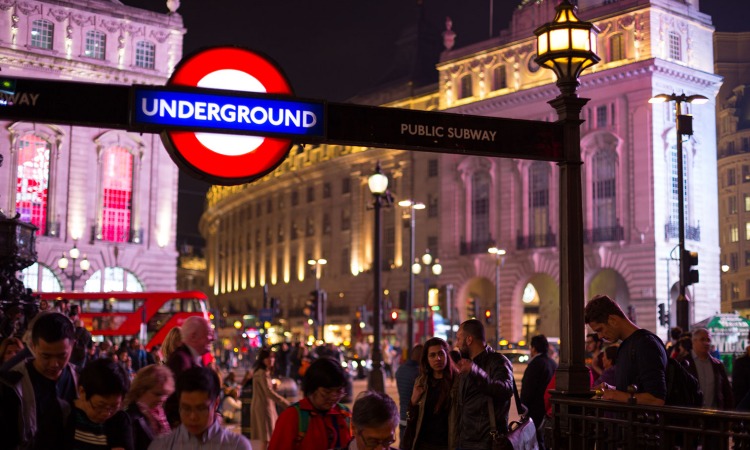
Credit: Transport for London
Transport for London (TfL) has announced that it has published its latest Business Plan, setting out how it will support London’s economic recovery and become more sustainable whilst achieving operational financial sustainability by 2023/24.
Across the plan, £8.1 billion will be invested in London’s road and rail network, as well as funding to boroughs provided for investment in their streets. The total investment in safe and active travel, across both operating and capital expenditure, will average £150 million per year across the Business Plan. This will allow further delivery of the capital’s strategic cycle routes, as well as the delivery of new cycleways and safer junctions to make London’s major roads safer and more attractive for those walking and cycling.
Furthermore, the plan will see the delivery of the London-wide Ultra Low Emission Zone (ULEZ) to further tackle the triple challenges of air pollution, the climate emergency and congestion. This will be supported by a £110 million scrappage scheme, as well as the expansion of outer London’s bus network.
The plan will also see TfL become the ‘green heartbeat’ for London, supporting the Mayor’s ambition for a net zero-carbon city by 2030 . Additional funding has been allocated to embed action on environment in TfL’s work, including to cut and adapt to the impacts of climate change on London’s public transport network. The plan also keeps the pathway open to London’s bus fleet transitioning to zero-emission by 2030.
In order to encourage customers back, TfL will also be investing in its infrastructure to keep services safe, clean and reliable, as well as delivering a range of improvements to London’s Tube, bus and rail network. This includes investment in the development of new trains to replace the ageing Piccadilly line fleet and a new fleet for the Docklands Light Railway.
As part of this, new signalling on the Circle line has now been delivered, and TfL will complete the remainder of the Four Lines Modernisation programme – delivering more frequent, reliable and faster journeys to the District, Hammersmith & City and Metropolitan lines. The project to modernise and expand Bank station will also be completed, transforming customer journeys at the heart of the city.
TfL’s new data shows continued rise in walking and cycling across London
The plan prioritises projects that will be financially viable within three to five years, and includes energy efficiency projects, which will further reduce TfL’s operating costs and contribute to meeting London’s environmental goals. TfL will also continue the work of becoming a more diverse and inclusive organisation and one that invests in staff welfare and facilities to ensure that it remains an attractive place to work.
Investing in new trains and signalling will create jobs and investment across the UK and help to grow the wider UK economy. To do this, long-term certainty on Government funding is needed past the current funding agreement to April 2024.
“Following tough negotiations and my commitment to prioritise funding for London’s vital public transport, TfL is on track for financial stability, ridership across the network is increasing and there have been major improvements to the capital’s public transport network,” said the Mayor of London, Sadiq Khan. “It is clear there are many challenges ahead, but TfL’s Business Plan sets out how London’s world-class public transport network will continue to contribute to a better, greener and fairer city for all Londoners.”
London’s Transport Commissioner, Andy Lord, said: “This plan shows how we will work to achieve our vision of being the green heartbeat of London, and how we will continue on the path to financial sustainability whilst delivering real and vital improvements for the city. It will deliver new trains for the DLR and the Piccadilly line, new cycleways, the new Thames crossing at Silvertown, safer junctions, an expanded Ultra Low Emission Zone and a new expansion of the bus network in outer London to support growth.”
In this Business Plan , TfL’s savings target is increasing to a total of £1 billion recurring savings, meaning a further £600 million per year needs to be delivered by 2025/26. This will be delivered through a focus on improving efficiencies, driving improvements where possible for TfL colleagues, and an approach to continuous savings, including working together with TfL’s supply chain to make further efficiencies.
The draft TfL Business Plan will be considered by the TfL Board on 7 December 2022.
If you liked this, you may also be interested in:
▶ TfL launches new challenge to find ways of making roads safer and more efficient
▶ Mayor of London’s plan to accelerate capital’s transition to electric vehicles
Related topics Air Quality , Alternative Power , Fleet Management & Maintenance , Mobility Services , Passenger Experience , Public Transport , Sustainable Urban Transport , Workforce Inclusivity , Workplace
Related modes Bus & Coach , Rail
Related cities London
Related countries United Kingdom
Related organisations Transport for London (TfL) , UK Government
Related people Andy Lord , Sadiq Khan

Transforming customer journeys: Enabling seamless travel with the latest ticketing & payment technology integration
By Intelligent Transport , sponsored by Pcentra
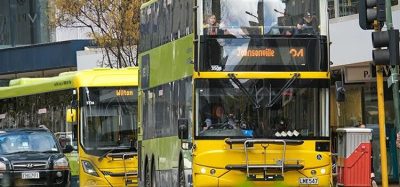
Metlink unveils major upgrades to Wellington city bus services
By Intelligent Transport

Île de France Mobilites to enhance accessibility of Melun station

Voi Technology discount scheme helps people in Liverpool with cost-of-living
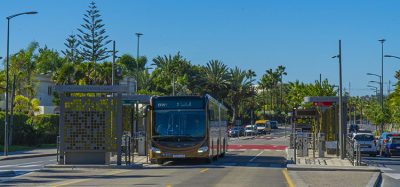
RATP Dev’s new BRT lines enhance urban mobility in Casablanca, Morocco
Leave a reply cancel reply.
Your email address will not be published. Required fields are marked *
This site uses Akismet to reduce spam. Learn how your comment data is processed .
© Russell Publishing Limited , 2010-2024. All rights reserved. Terms & Conditions | Privacy Policy | Cookie Policy
Website design and development by e-Motive Media Limited .

Privacy Overview
This website uses cookies to improve your experience while you navigate through the website. Out of these cookies, the cookies that are categorised as "Necessary" are stored on your browser as they are as essential for the working of basic functionalities of the website. For our other types of cookies "Advertising & Targeting", "Analytics" and "Performance", these help us analyse and understand how you use this website. These cookies will be stored in your browser only with your consent. You also have the option to opt-out of these different types of cookies. But opting out of some of these cookies may have an effect on your browsing experience. You can adjust the available sliders to 'Enabled' or 'Disabled', then click 'Save and Accept'. View our Cookie Policy page.
Necessary cookies are absolutely essential for the website to function properly. This category only includes cookies that ensures basic functionalities and security features of the website. These cookies do not store any personal information.
Performance cookies are includes cookies that deliver enhanced functionalities of the website, such as caching. These cookies do not store any personal information.
Analytics cookies collect information about your use of the content, and in combination with previously collected information, are used to measure, understand, and report on your usage of this website.
Advertising and targeting cookies help us provide our visitors with relevant ads and marketing campaigns.
TfL to find hundreds of millions in savings, plan suggests
- Published 1 December 2022
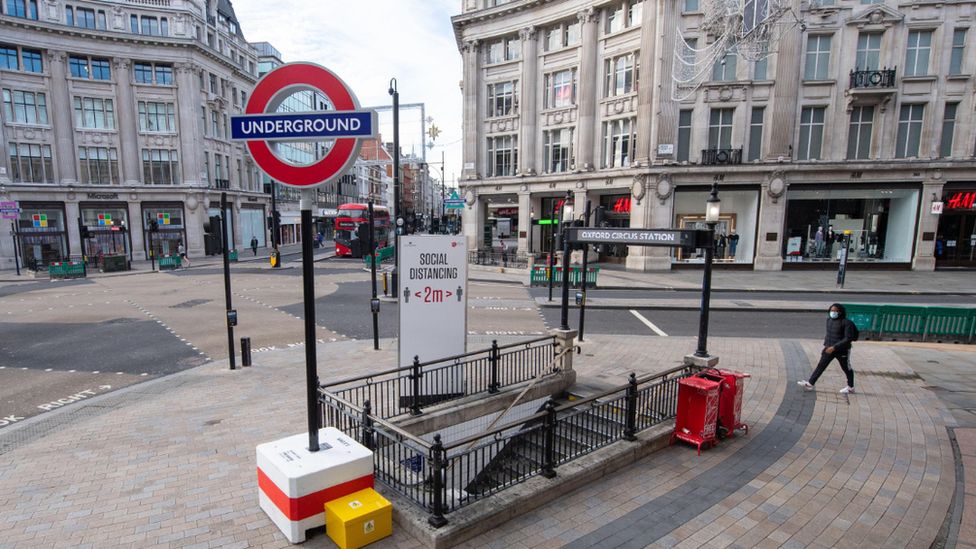
The lockdowns caused passenger revenue to plummet
Transport for London (TfL) will need to find an additional £600m a year in savings by 2025-26, according to its draft Business Plan.
It said it was down to inflation and the requirements of the recent government bailout.
TfL says it will do this by "improving efficiencies" but that services will not be cut.
It also assumes that fares will rise by 4% until 2024, rather than being tied to inflation.
TfL has endured a difficult few years since the emergence of Covid. Revenue from fares plummeted as passengers stayed at home, and some are yet to return. TfL says passenger numbers are at about 80% of pre-pandemic levels.
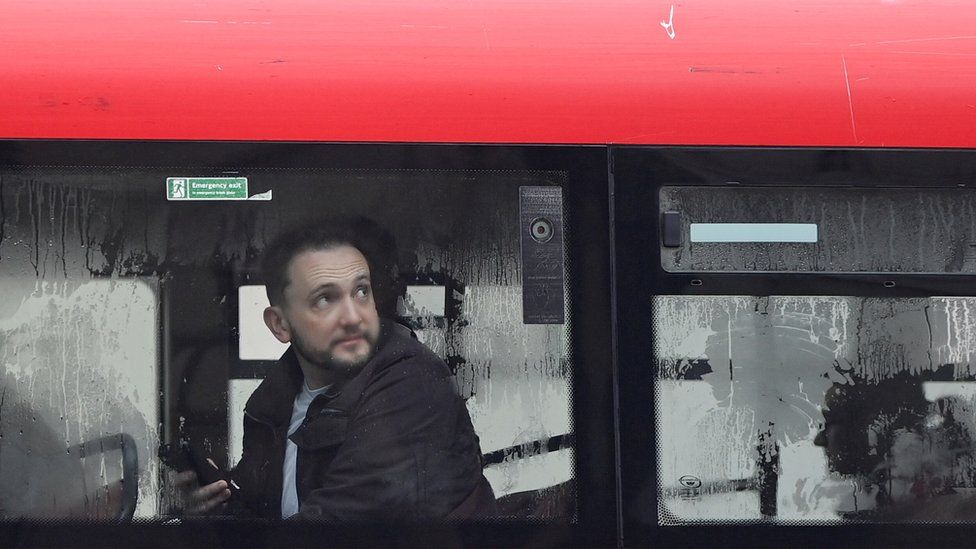
There will be more buses in outer London
A series of short-term government bailouts was followed by a funding agreement with the Department for Transport, which lasts until the end of March 2024.
In its draft Business Plan , external , TfL forecasts it will by that point break even on its "operating account" - the money used to make the the Tube, buses and trains run day to day, as well as to pay staff.
To break even, TfL needs to encourage more passengers to use its services. However, it says the cost-of-living crisis means poorer households, renters and people with large mortgages are "more likely to make cutbacks" and may not travel as frequently. TfL's targets assume that it will take more than four years before travel returns to pre-pandemic levels.
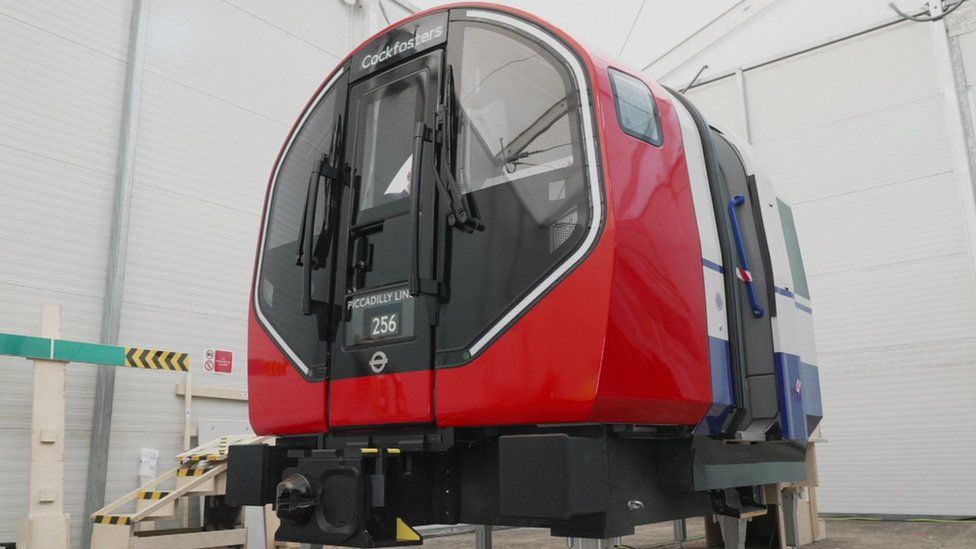
Londoners can still look forward to new Piccadilly line trains
Fares may not rise as much as anticipated. Normally they rise by inflation plus 1%. However, TfL says that until 2024 "our passenger income is set to the Department for Transport's revenue scenario" which assumes fares will increase by 4% in March 2023 and March 2024.
But this is not set in stone: the final decision on fares rests with the mayor.
TfL commissioner Andy Lord said he could "once again look to the future with optimism".
"This plan shows how we will work to achieve our vision of being the green heartbeat of London, and how we will continue on the path to financial sustainability whilst delivering real and vital improvements for the city."
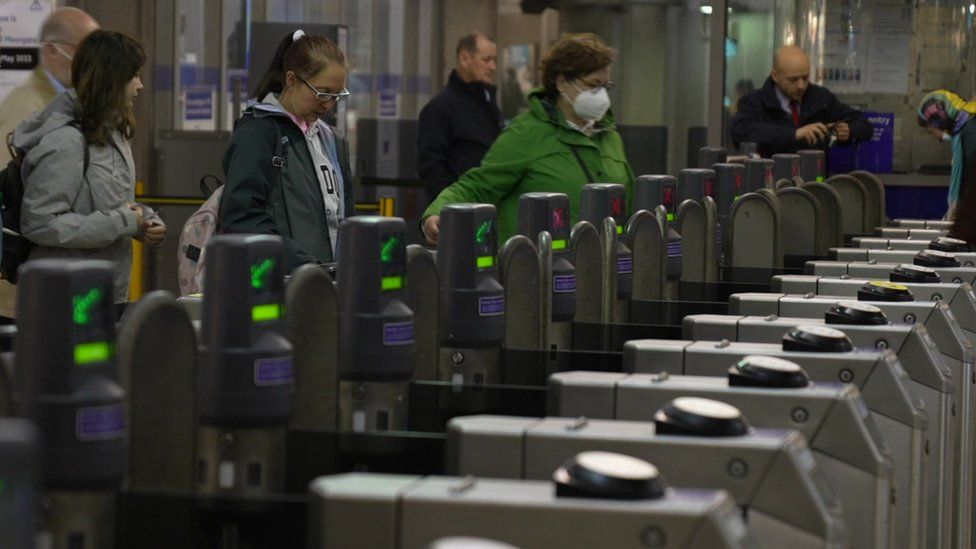
The final decision on fare increases rests with the mayor
Separately, over £8bn will be invested in London's road and rail network. Londoners can look forward to new Piccadilly line and DLR trains, new zero-emission buses, 14km of new cycleways, and more buses in outer London.
This capital expenditure is separate from the budget for the day-to-day running of the network. TfL has other plans to improve infrastructure such as new signalling on the Piccadilly line, but it says it needs new capital funding from the government.
Follow BBC London on Facebook , external , Twitter , external and Instagram , external . Send your story ideas to [email protected] , external
Related Topics
- Transport for London
Ultra Low Emissions Zone to cover all of London
- Published 25 November 2022
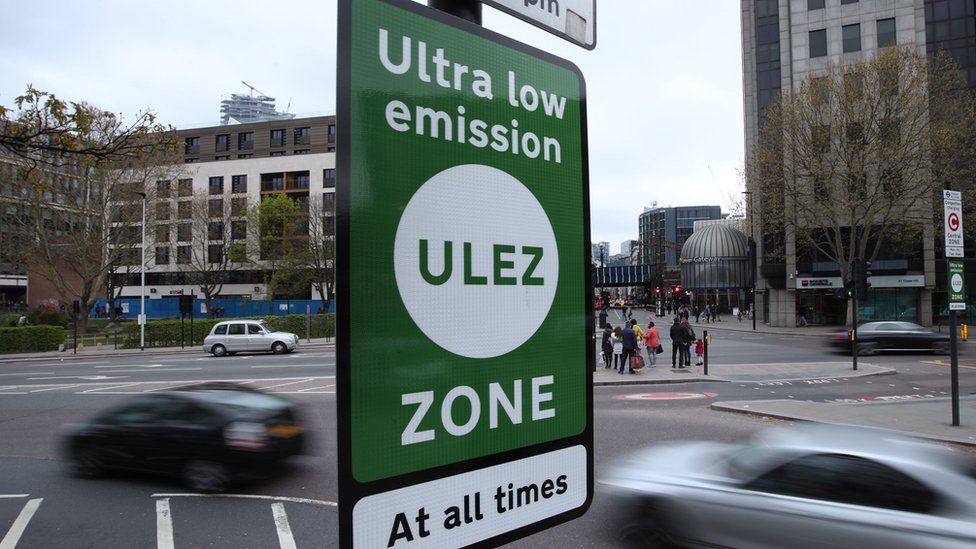
New £3.6bn London transport funding deal agreed
- Published 30 August 2022
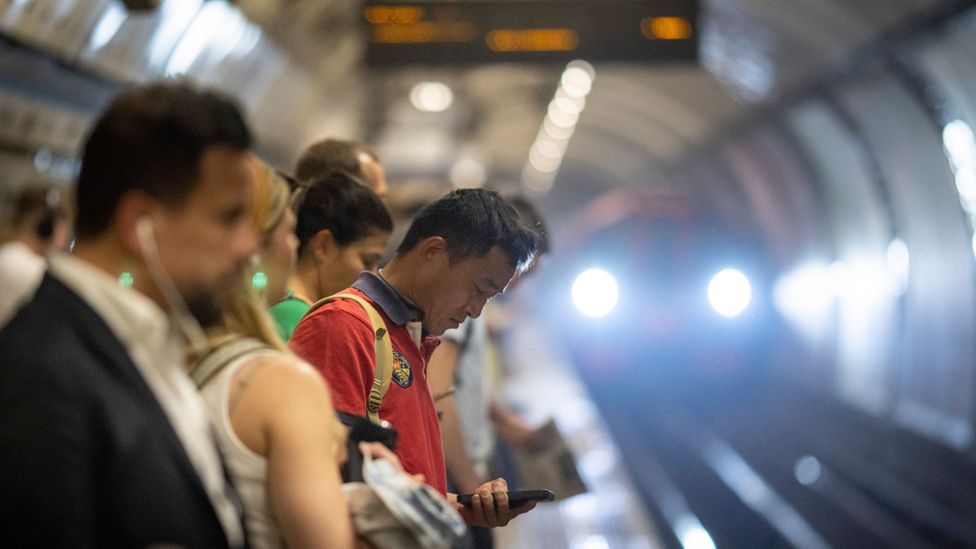

Could the Elizabeth line £3.2bn extension to Ebbsfleet really happen?
P lans for an Elizabeth line extension further into South East London and Kent got fresh backing from councils despite questions over the huge £3.2billion cost.
Transport for London ( TfL ) has been looking into an expansion eastwards beyond Abbey Wood to link up with the Southeastern High Speed 1 route at Ebbsfleet.
This would also enable the Elizabeth line, which opened in May 2022 at a cost of £19billion , to link up with Eurostar services at Ebbsfleet towards Paris, Brussels and Amsterdam should they recommence having been paused during the pandemic.
London Mayor Sadiq Khan is known to be supportive of the idea in principle, but the main issue is the major funding required to upgrade the railway east of Abbey Wood.
TfL has also looked at two upgrades on the western section - linking Heathrow to Langley on the proposed Western Rail Link, and to Staines on the Southern Rail Link.
Planners are also considering how the HS2 station at Old Oak Common will impact the line, with a new hub now being built to connect passengers with Central London.
The Elizabeth line has had a bumpy ride since opening, with 350million passenger journeys made so far on a service which has sped up travel in London - but regular delays and infrastructure issues which have seen trains stranded and plans ruined.
Early proposals for Crossrail had included it going to Gravesend, but this was cut back in the 1990s, before a review in 2004 recommended ending it at Abbey Wood. Some provision was however included in the designs to build an extension later on.
Now, councils which are part of lobbying group Local London have commissioned a review of 13 transport options including the Elizabeth line extension to Ebbsfleet in an attempt to push them forward.
From Cross London Rail Links to Crossrail: A 22-year timeline of the capital's Elizabeth line
London's Crossrail project has suffered numerous setbacks over the past two decades, as follows:
January 2002 : Cross London Rail Links Ltd, a joint venture between the Strategic Rail Authority and Transport for London (TfL), is set up to develop plans for Crossrail.
July 2004 : The Government commits to introducing legislation to enable Crossrail to proceed.
October 2007 : Prime Minister Gordon Brown gives the green light for the project. It is expected to cost £15.9 billion and open in December 2017.
May 2009 : London Mayor Boris Johnson and Transport Secretary Lord Adonis break ground on the project at Canary Wharf.
October 2010 : Crossrail's budget is cut to £14.8 billion in the Conservative and Liberal Democrat coalition government's comprehensive spending review. Its opening date is pushed back 12 months to December 2018.
January 2014 : The National Audit Office says the scheme is 'just behind schedule', adding that Crossrail Ltd 'remains confident' it will open on time.
May 2015 : Tunnel boring is completed as a tunnelling machine named Victoria arrives at Farringdon. Some 13 miles of new tunnels have been dug under London.
February 2016 : The Queen visits Bond Street station and announces the railway will be named the Elizabeth line in her honour.
July 2018 : Rail minister Jo Johnson announces that Crossrail's budget has risen to £15.4billion as 'cost pressures have increased across the project'.
August 2018 : Crossrail Ltd announces it will miss its December 2018 opening date but the central section 'will open in autumn 2019'. The project is suffering from construction delays and difficulties installing complex signalling systems.
December 2018 : TfL says Crossrail may be delayed further and could require a £2billion funding boost, taking the cost up to £17.6billion. The Government, TfL and London Mayor Sadiq Khan agree a financial package.
December 2018 : Sir Terry Morgan resigns as chairman of Crossrail Ltd and HS2, days after predicting he would be sacked. He is replaced at Crossrail by London Underground managing director Mark Wild.
April 2019 : A 'delivery window' between October 2020 and March 2021 is announced for the central section of Crossrail.
November 2019 : Crossrail Ltd announces that the railway will open 'as soon as practically possible in 2021'. The cost has increased by up to £650 million to £18.25billion.
January 2020 : The 'latest assessment' is that services will commence in summer 2021.
July 2020 : Crossrail Ltd says the railway will not open in summer 2021 because of delays caused by the coronavirus pandemic. It does not give an updated schedule.
August 2020 : It is announced that the line will open in the first half of 2022.
July 2021: The National Audit Office says the estimated total cost of Crossrail is £18.9billion.
May 17, 2022 : The Queen and Prime Minister Boris Johnson visit Paddington station to celebrate the completion of Crossrail.
May 24, 2022 : Elizabeth line services are launched in three sections. The line has services on Monday to Saturday from Paddington to Abbey Wood. Services from Reading and Heathrow to Paddington, and from Shenfield to Liverpool Street, are rebranded from 'TfL Rail' to the 'Elizabeth line'.
November 6, 2022 : The three sections are integrated. Services from Reading and Heathrow now operate through to Abbey Wood. Services from Shenfield go through to Paddington.
May 21, 2023 : The full timetable of up to 24 trains per hour is introduced, with direct trains from Shenfield to Heathrow for the first time - but not from Shenfield to Reading.
May 24, 2024 : On its two-year anniversary, TfL says 350million passenger journeys have been made.
The local authorities - Barking and Dagenham, Bexley, Bromley, Enfield, Greenwich, Havering, Newham, Redbridge and Waltham Forest – claim investment in transport infrastructure in their areas of London has not kept pace with 'significant demographic change and population growth, out-stripping national and London averages'.
And the group has now commissioned economic and social research consultancy Eksogen to analyse the impact of investing in the Elizabeth line extension in the nine-borough region.
The Campaign for Better Transport is among the groups backing the plans. Its spokesman Michael Solomon Williams told MailOnline today: 'The economic and environmental case for investing in rail is strong, especially in this major growth region which has suffered from insufficient network coverage for too long. Just this week the Elizabeth line has announced that it has doubled its return on investment in two years.
'Extending it would bring modern, sustainable travel to the region, as well as supporting the case for reopening Ebbsfleet International - much needed for international rail growth - and for the proposed tram network between Kent and Essex.'
And Thomas Turrell, the Conservative London Assembly Member for Bexley and Bromley, told MailOnline: 'Cities are built on their transport networks which is why we need to ambitious.
'I fully support extending the Elizabeth line to Ebbsfleet via Erith. Such an extension would be a real shot in the arm for the local economy.
'It would create even more jobs and opportunities across the north of Bexley as well as providing local commuters with a faster, more reliable route into Central London. It would also provide a direct connection between Ebbsfleet and Heathrow.'
It comes after an informal group of authorities called the Crossrail to Ebbsfleet (C2E) Partnership was formed in 2016 to promote extending the Elizabeth line towards Ebbsfleet.
Shortly after, it received support from National Infrastructure Commission chairman Sir John Armitt and the Government committed £4.85million for a study into options for the route.
An 'Abbey Wood to Ebbsfleet Connectivity Study' was later completed and the results considered by C2E, which has since launched another consultation on a refined shortlist of options.
Mr Khan has already set out support for a 'Government-led extension' to the line and has included the Ebbsfleet expansion in his transport strategy.
And the route to extend Elizabeth line services from Abbey Wood to Hoo Junction in Kent, located just east of Gravesend, was safeguarded as part of the Crossrail Bill.
Local London said a business case is now with the Government and C2E is awaiting feedback, although the partnership is still making the case particularly in the light of the success of the current Elizabeth line in terms of high demand.
The proposal was initially costed at £1.5billion, but the most recent estimate is between £2.6billion and £3.2billion.
This would be the budget for a plan that sees eight of the 12 Elizabeth line services per hour that terminate at Abbey Wood being extended eastwards, sharing the existing North Kent line tracks with Southeastern and Thameslink services.
Of the eight trains per hour, four would terminate at Northfleet, with the remaining four continuing to Gravesend.
The Elizabeth line trains would stop at all the stations on the North Kent line between Abbey Wood and Gravesend.
The option would require changes to existing Southeastern services, and the construction of some sections of extra track and junction works within the existing rail corridor.
There would also have to be major works at Abbey Wood, Slade Green and Dartford stations and additional land would be needed to accommodate additional train stabling.
In June 2022, transport body Transport for the South East outlined how it could gather £3.2billion of funding to build the extension to Ebbsfleet and beyond to Gravesend.
Great British Railways, the proposed state-owned public body, would have to agree to be the main delivery partner for the scheme. Money would also be needed from Government funding from broader programmes such as the Housing Infrastructure Fund.
In addition cash would also be needed from the Mayor, the Greater London Authority and TfL – which could prove to be a major stumbling block given recent pressure on the organisation's finances.
Local contributions would also be required from authorities within the C2E.
But there was a setback after the troubled London Resort theme park project was mothballed in March 2022, because it was hoped that the developers could have also got involved.

The 13 transport options in South East London to be reviewed
The 13 transport options which will be reviewed after a commission by lobbying group Local London are:
- A13 and South Barking improvements
- Bakerloo Line extension
- Elizabeth line to Ebbsfleet
- Enfield to Liverpool Street Overground
- Lower Thames Crossing
- River Roding Crossing
- Stratford International
- Stratford station
- Thames ferry crossings
- Thames piers and wharves development (including river bus options)
- Thamesmead and Beckton Riverside Public Transport Programme (including DLR extension to Belvedere)
- Walthamstow Central
The hope now is that the extension will make it much easier and quicker for people in South East London and Kent to travel within the area or to reach Central London and Heathrow.
Southeastern currently provides most rail services on the North Kent lines into London, with services into London Bridge, Charing Cross, Cannon Street, and Victoria.
Thameslink also serves the area with trains operating through Central London from Rainham to Luton.
As for the Elizabeth line, the network has been a major success for TfL with more than 350million journeys made on its trains since the first service ran on May 24, 2022 - and demand already above post-pandemic expectations.
But it has been a troubled development at times. Before it even launched in May 2022, the Crossrail project suffered numerous issues including construction difficulties and complications installing signalling systems which delayed the opening multiple times.
This was much to the frustration of many homeowners buying properties along the route during the construction period in the hope of having an easier commute.
In 2007, the line was given an opening date of December 2017, and set a budget of £14.8billion in 2010.
But the estimated final cost was £18.9billion, including £5.1billion from the Government - making it more than £4billion over budget.
In 2010, the opening was pushed back by a year to take place in December 2018 - but just four months before this date, in August 2018, it was announced that the line would in fact not open on time.
Four years later the Elizabeth line did eventually open in May 2022 - but only in three sections, with services on the new part from Paddington to Abbey Wood.
Existing services from Reading and Heathrow to Paddington, and from Shenfield to Liverpool Street, were also rebranded from 'TfL Rail' to the 'Elizabeth line' at this point.
The grand opening was long awaited, and its first service from Paddington saw international rail enthusiasts travelling to the capital and queueing for more than six hours to get on board - with Mr Khan pictured hugging TfL officials in delight.
However the first day was also blighted by a fire alarm being activated which saw Paddington evacuated.
The line initially opened in three sections - from Reading/Heathrow to Paddington, Liverpool Street to Shenfield and the new Paddington to Abbey Wood part.
Then in November 2022, the second stage began which saw through trains start running from Reading and Heathrow to Abbey Wood; and Shenfield to Paddington.
The final stage from May 2023 saw services start running from Shenfield to Heathrow, as well as the existing Reading and Heathrow to Abbey Wood offering.
The Elizabeth line saw more than 150million passenger journeys during its first full year of operation, then this rose significantly to 210million in 2023/14 – and the line now has about 700,000 passenger journeys every weekday.
The busiest day so far was recorded on April 18, 2024 with 787,000 journeys – and the busiest station is Tottenham Court Road, followed by Liverpool Street.
However the line has also suffered from major infrastructure problems and train faults, which peaked in December last year when commuters were trapped in the dark for four hours on a train outside Paddington .
Two people were injured and passengers had to walk down freezing tracks in the dark amid the chaos following damage to overhead cables.
But there has been a notable decline in problems in recent months after Network Rail launched a major project to focus on repairing issues in the western section.
And TfL bosses will be hoping upcoming data from the Office of Rail and Road will confirm an improvement in punctuality.
Now, the link-up between Local London and Eksogen will also see a total of 13 transport projects studied, including the Elizabeth line extension.
Further suggested improvements include the development of Thames piers and wharves, the proposed Bakerloo line extension, Stratford International station and the Lower Thames Crossing.
Baroness O'Neill of Bexley, chairman of Local London and leader of the London Borough of Bexley, said: 'As the fastest growing part of London, we need investment in transport infrastructure to ensure residents can access work, education and leisure activities easily.
'Ekosgen's research will quantify the economic growth, housing and job supply benefits of investing in transport, and identify projected transport needs of this fast-growing part of London. This is about ensuring inclusive and sustainable growth across our boroughs now and in the future.'
Margaret Collins of Ekosgen added: 'We are delighted to be working with Local London on this commission. This is an important piece of work which will help to drive economic growth across this sub-region.
'The work builds on recent studies carried out across the country to help secure investment in places, and our local track record in this part of London.'
A Government source told MailOnline today TfL is devolved and it is therefore for Mr Khan to deliver services in the capital.
The Department for Transport and TfL both declined to comment.

- Dec 2, 2022
TfL publishes new draft Business Plan

Transport for London has published its latest Business Plan, which sets out how it aims to support London’s economic recovery and “become the green heartbeat of London” whilst achieving operational financial sustainability by 2023/24.
It says the plan charts how, across the next three and a half years, TfL will play a key role in improving air quality and tackling the climate emergency, encouraging walking and cycling as well as investing in public transport.
Across the plan, £8.1bn will be invested in London’s road and rail network, as well as funding to boroughs provided for investment in their streets. The total investment in safe and active travel, across both operating and capital expenditure, will average £150m per year across the Business Plan. This will allow further delivery of the capital’s strategic cycle routes, as well as the delivery of new cycleways and safer junctions to make London’s major roads safer and more attractive for those walking and cycling.
In a statement, TfL says “the plan will see the delivery of the London-wide Ultra Low Emission Zone to further tackle the triple challenges of air pollution, the climate emergency and congestion, and to ensure five million more Londoners can breathe cleaner air. From Tuesday 29 August 2023, the zone will operate across all London boroughs, up to the existing Low Emission Zone boundary. The expansion will be supported by a £110m scrappage scheme to support certain Londoners on lower incomes, disabled Londoners, charities and micro businesses and sole traders and the bus network in outer London will be expanded.
“Extreme weather events, including heatwaves, flooding and severe storms, show that climate change is already impacting London. The plan will see TfL become the ‘green heartbeat’ for London, supporting the Mayor’s ambition for a net zero-carbon city by 2030. Additional funding has been allocated to embed action on environment in TfL’s work, including to cut and adapt to the impacts of climate change on London’s public transport network. The plan also keeps the pathway open to London’s bus fleet being zero emission by 2030.”
The statement continues:
“London continues to recover from the pandemic, and with funding arrangements in place with the Government and the Greater London Authority, TfL now has financial certainty into 2024. Since restrictions were lifted on public transport in early 2022, ridership on Tube, bus and rail services has increased and is now at around 80 per cent, across a weekly average, compared to that seen before the pandemic.
Weekend ridership levels on Tube and bus increasingly edge towards those seen pre-pandemic, and TfL is now working hard and creatively to rebuild ridership.
“A key part of encouraging customers back will be TfL investing in its infrastructure to keep services safe, clean and reliable, as well as delivering a range of improvements to London’s Tube, bus and rail network. This includes investment in the development of new trains to replace the ageing Piccadilly line fleet and a new fleet for the Docklands Light Railway. New signalling on the Circle line has now been delivered, and TfL will now complete the remainder of the Four Lines Modernisation programme – delivering more frequent, reliable and faster journeys to the District, Hammersmith & City and Metropolitan lines. The project to modernise and expand Bank station will also be completed, transforming customer journeys at the heart of the city.
“The plan prioritises projects that will be financially viable within three to five years, and includes energy efficiency projects, which will further reduce TfL’s operating costs and contribute to meeting London’s environmental goals. TfL will also continue the work of becoming a simpler and even more effective organisation, a more diverse and inclusive organisation and one that invests in staff welfare and facilities to ensure it remains an attractive place to work.
“Investing in new trains and signalling will create jobs and investment across the UK and help to grow the wider UK economy. To do this, long-term certainty on Government funding is needed past the current funding agreement to April 2024. Like every other major transport authority around the world, TfL will need ongoing Government support for capital investment and throughout previous discussions with Government, it has consistently been recognised that TfL is not expected to fund major capital enhancements from its own operating incomes. Discussions on shared priorities for future capital investment between TfL and the Government have already commenced.”
The Mayor of London, Sadiq Khan, said: “The past two years have been the most challenging in TfL’s history and the pandemic’s impact on TfL’s finances was devastating. But, following tough negotiations and my commitment to prioritise funding for London’s vital public transport, TfL is on track for financial stability, ridership across the network is increasing and there have been major improvements to the capital’s public transport network.
“This year we’ve seen the opening of the transformational Elizabeth line, the extension of the Overground to Barking Riverside, the completion of important upgrades to the Northern line, and I’ve unlocked additional funding to save bus services that were under threat as well as expanding the bus network in outer London. London’s transport workers continue to play an essential and much-valued role in keeping our city’s transport network safe and operating, and this is why I took the unprecedented action to support London’s lowest-paid transport workers by removing the cost of using public transport.
“It is clear there are many challenges ahead, but TfL’s Business Plan sets out how London’s world-class public transport network will continue to contribute to a better, greener and fairer city for all Londoners.”
London’s Transport Commissioner, Andy Lord, said: “The pressures of the pandemic and the financial crisis that it created put London and TfL under greater pressure than at any point in the past two decades. Now London is emerging from the pandemic, and we have funding certainty into 2024, so we can once again look to the future with optimism.
“This plan shows how we will work to achieve our vision of being the green heartbeat of London, and how we will continue on the path to financial sustainability whilst delivering real and vital improvements for the city. It will deliver new trains for the DLR and the Piccadilly line, new cycleways, the new Thames crossing at Silvertown, safer junctions, an expanded Ultra Low Emission Zone and a new expansion of the bus network in outer London to support growth.
“With improvements like the Elizabeth line, the Overground extension to Barking Riverside and the extension of the Northern line to Battersea, we have shown the power of transport investment. With continued Government capital investment from April 2024 we can continue to support our city and make it an even better, greener, safer and more successful place. This work is crucial to the economy of London, and will benefit the UK as a whole.”
TfL concludes that, while good progress is being made with TfL’s savings target, having delivered £400m of the £730m recurring savings target set in 2019, the pressures of managing inflation and the requirements of the most recent funding agreement mean that further efficiencies are needed. Therefore, in this Business Plan, the savings target is increasing to a total of £1bn recurring savings, meaning a further £600m per year needs to be delivered by 2025/26.
This will be delivered through a focus on improving efficiencies, driving improvements where possible for TfL colleagues, and an approach to continuous savings, including working together with TfL’s supply chain to make further efficiencies.
Recent Posts
Costain secures new AMP8 Framework Agreement with United Utilities
Hull City Council unveils new visuals ahead of public engagement on plans for Preston Road Cycle Scheme
Scottish Southern Electricity Networks (SSEN) and Network Plus sign contract for underground cabling in the Ridgeway area
Recent Blog Posts
News and updates.
Thanks for submitting - We will be in touch shortly.
SIGN UP TO OUR NEWSLETTER
Thanks for subscribing - We respect your privacy.
© 2021 SAFER HIGHWAYS . CREATED BY LVETHT .
- International
June 4, 2024 - Modi declares victory in India election as BJP party faces shock setbacks
By Rhea Mogul, Jessie Yeung, Diksha Madhok, Antoinette Radford and Tori B. Powell, CNN
Our live coverage for the day has ended. Follow the latest India election news or read through the updates below.
Photos: Scenes from India's general election
The votes were counted Tuesday after the world's largest election was held in India.
From April 19 to June 1, more than 640 million people cast their vote at polling stations from the high peaks of the Himalayas to the remote jungles of the west.
Prime Minister Narendra Modi declared victory on Tuesday – but his goal of winning an unassailable majority lay in tatters with early results showing voters reduced the extent of his party’s grip on power.
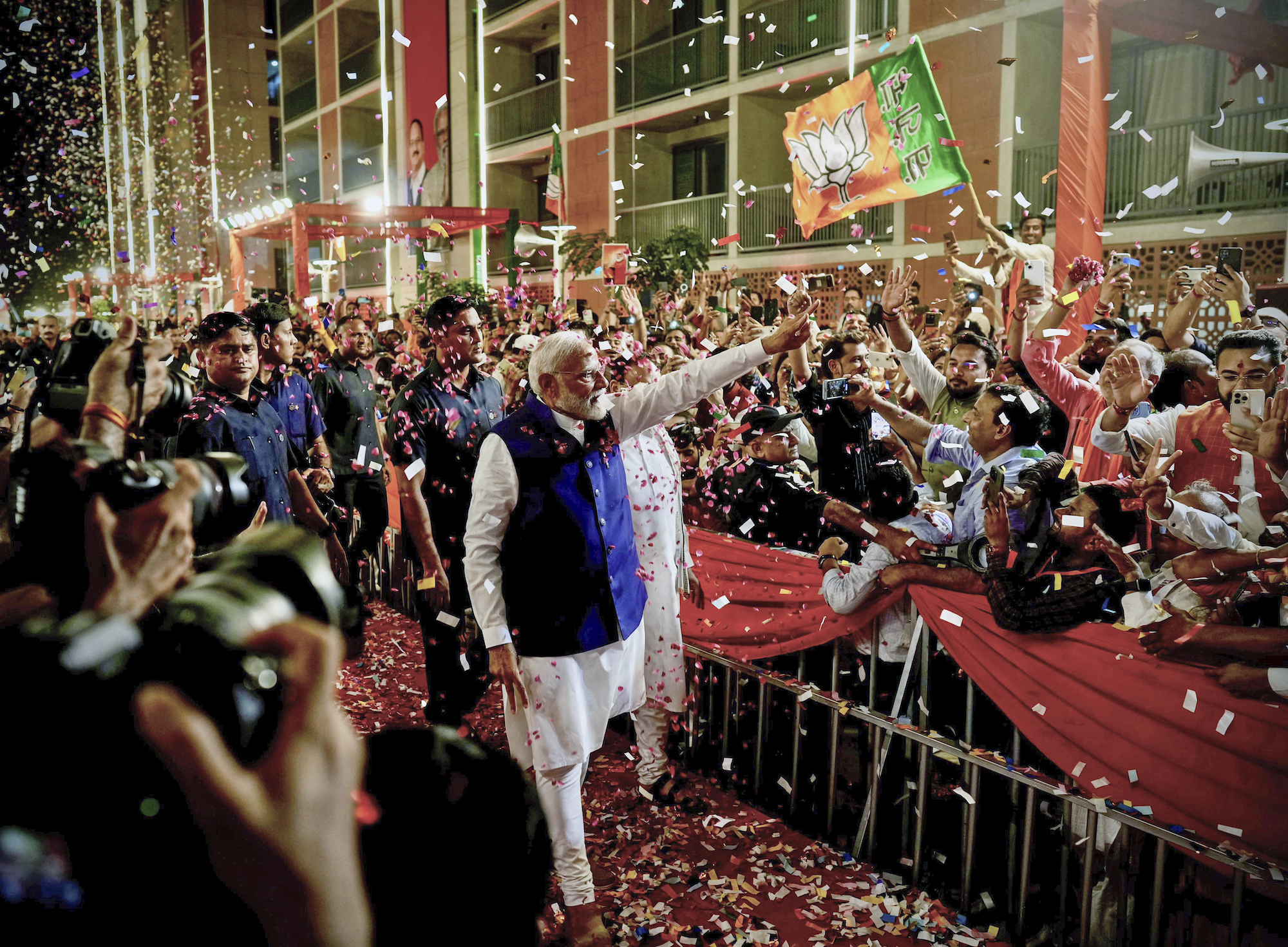
Analysis: Modi, Ambani and Adani — the men shaping India’s economy
Analysis from CNN’s Diksha Madhok
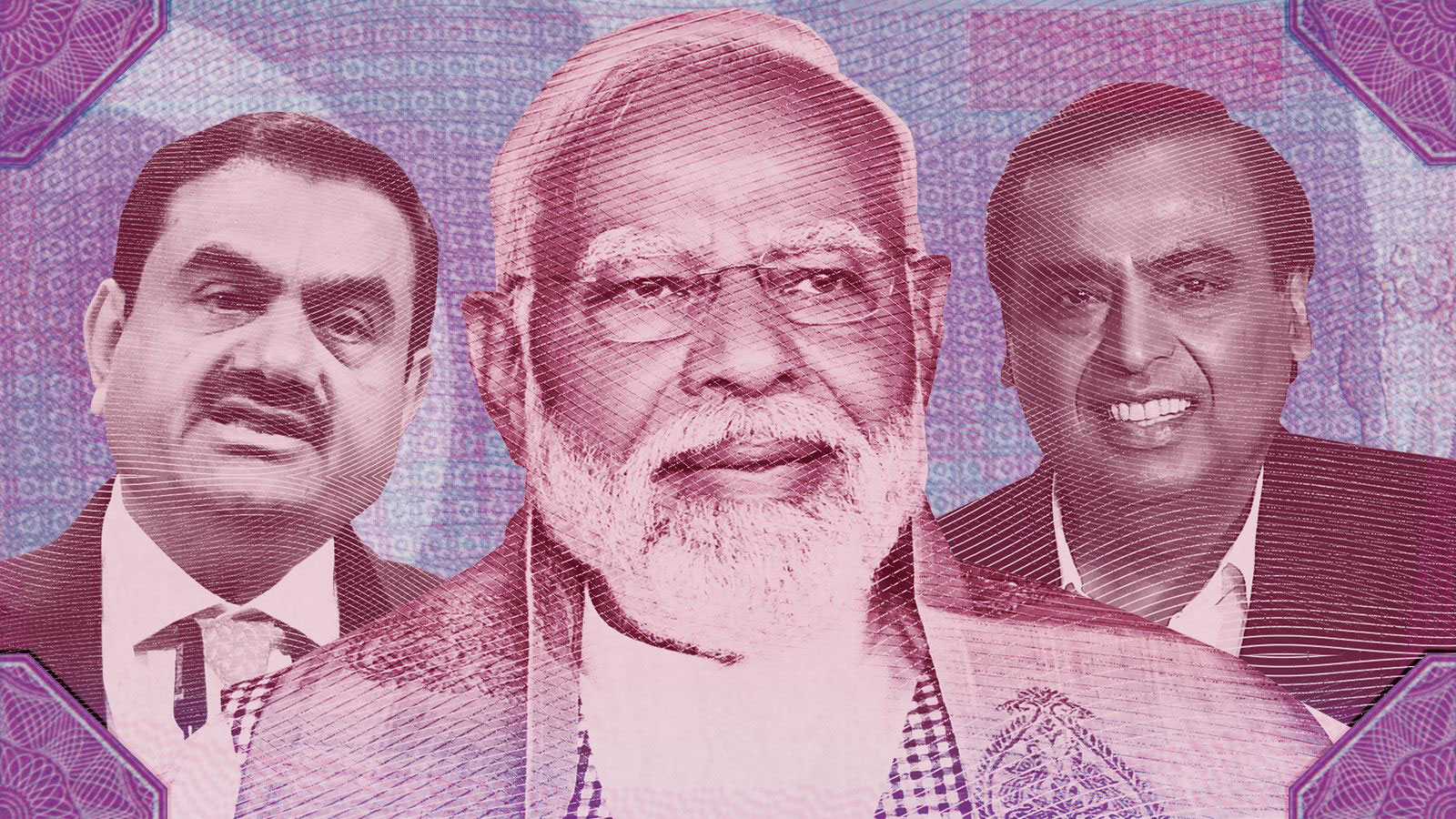
In less than a decade, Asia’s richest man Mukesh Ambani has upended India’s telecom sector and become a top player in sectors ranging from media to retail as chairman of India’s most valuable private company: Reliance Industries.
His ambition and breathless pace of expansion is matched by Gautam Adani, founder of the Adani group, who helms businesses ranging from ports and power to defense and aerospace.
Reliance Industries and the Adani Group are sprawling conglomerates worth over $200 billion each, with businesses in sectors ranging from fossil fuels and clean energy to media and technology.
Investors have been cheering the duo’s ability to adroitly bet on sectors prioritized for development by Prime Minister Narendra Modi.
As a result, these three men — Modi, Ambani and Adani — are playing a fundamental role in shaping the economic superpower India will become in the coming decades.
The South Asian country is poised to become a 21st-century economic powerhouse, offering a real alternative to China for investors hunting for growth and manufacturers looking to reduce risks in their supply chains.
Worth $3.7 trillion in 2023, India is the world’s fifth largest economy, jumping four spots in the rankings during Modi’s decade in office and leapfrogging the United Kingdom.
Sustained expansion will push India higher up the ranks of the world’s biggest economies, with some observers forecasting the South Asian nation to become number three behind only the US and China by 2027.
Despite these successes, soaring youth unemployment and inequality remain stubbornly persistent problems. In 2022, the country ranked a lowly 147 on gross domestic product (GDP) per person, a measure of living standards, according to the World Bank.
To spur growth, the Modi government has begun a massive infrastructure transformation and heavily promoting digital connectivity — with Adani and Ambani becoming key allies.
Both tycoons are considered vocal champions of Modi, and prominent politicians from opposition parties in India have often questioned Modi’s ties with India’s super-rich.
Read the full analysis.
CNN’s Jessie Yeung contributed to this report from Mumbai.
Analysis: Is India's free press not so free after a decade of Modi?
Analysis from CNN’s Aishwarya S. Iyer

India is one of the largest media markets in the world , according to Reporters Without Borders (RSF), with more than 20,000 daily newspapers across the country and about 450 privately owned channels dedicated to news, which broadcast in dozens of languages.
Yet despite its size and diversity, critics say the media industry is growing increasingly subservient to Modi’s government.
“There was a blend of public service, public interest and corporate private media that served a burgeoning urban middle class, but also showed interest in issues of rural development. Journalists were respected… Regulatory mechanisms were weak but not completely absent,” said Shakuntala Banaji, media professor at the London School of Economics. “They have been all but destroyed in the last 10 years.”
India fell 25 places on the Press Freedom Index between 2015 and 2023, to 161st place — below neighboring Pakistan, Sri Lanka, and Nepal. In the latest index for this year it rose slightly to 159th place but remains below all neighbors except Bangladesh (165th).
“There has been a sharp deterioration in the status of media over the last 10 years,” Committee to Protect Journalists (CPJ) India representative Kunal Majumder told CNN, adding that this included imprisonment and invoking terror laws to criminalize journalists.
There has also been an uptick, it said, in the use of anti-terror laws — which allow for detention without trial or charge for up to 180 days — against reporters.
Prime Minister Narendra Modi has not taken a single solo press conference in his decade-long rule.
The government of the popular but divisive leader stands accused by opponents of suppressing media pluralism.
Modi critics fear further erosion of the protections afforded to India’s free press if he is elected.
Meet the winners of India's economic boom
From CNN's Jessie Yeung, Priti Gupta and Esha Mitra
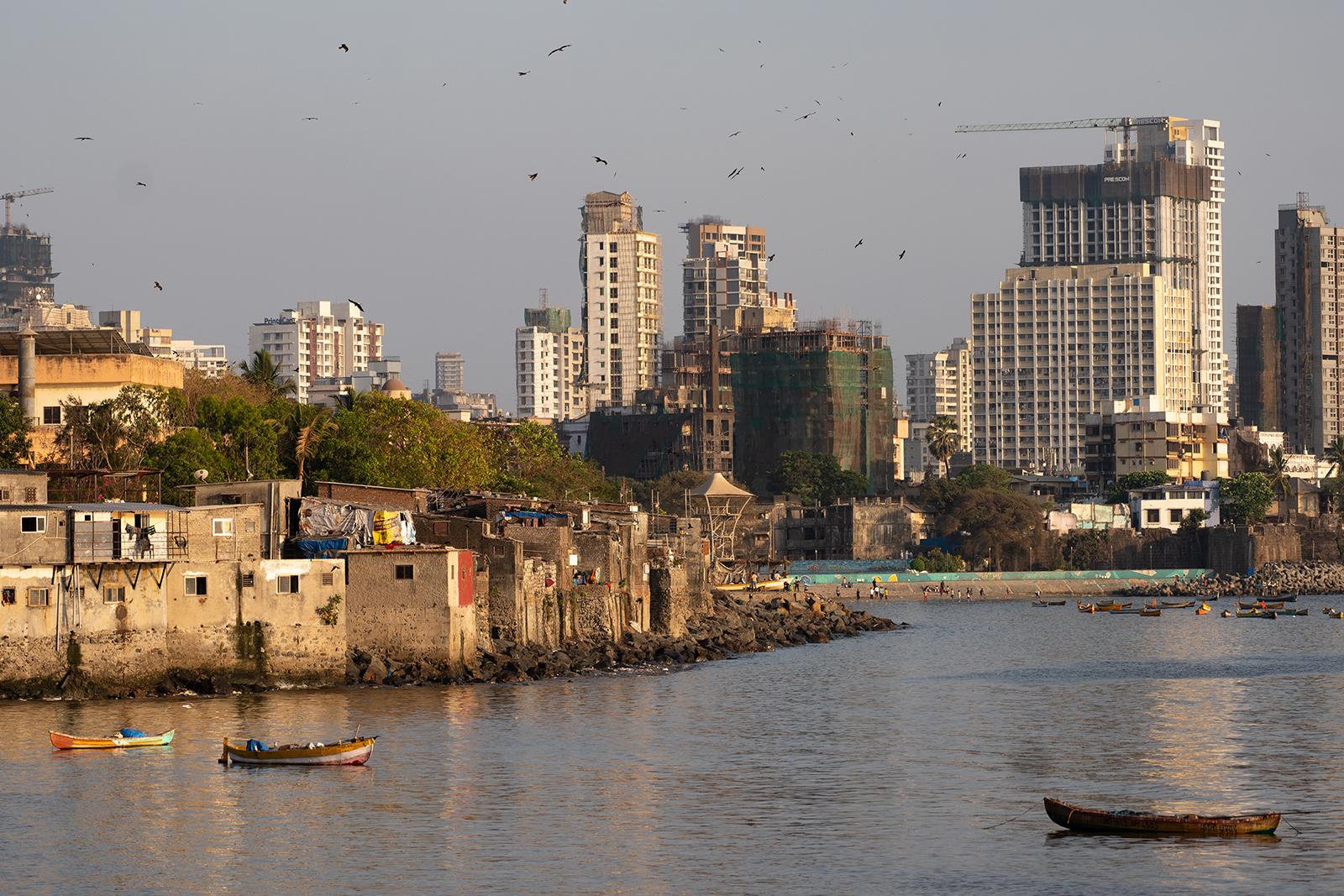
More than 40% of India’s 1.4 billion people are under 25: a tech-savvy and mostly English-speaking labor force. Like millions of migrants, many of them are drawn to the country’s financial capital Mumbai, full of aspiration and ambition. And it’s stories like these that inspire them.

The tech developer: Growing up in the slums of Mumbai, Javed Khatri never used a smartphone or computer.
“In the region where I used to stay, one of the best things that one could think of was just to complete 10th grade, and then work at a call center or sell vegetables or work at a garage or do some kind of odd jobs,” says Khatri, now 30. “That was our topmost ambition.”
But unlike many children in the slums, he completed 10th grade – the first person in four generations of his family to do so – then studied computer science at an engineering college.
He is now building an online platform to connect tech firms with engineers. He moved his family out of the slum, and supports his parents. Both his siblings went to college and pursued their own careers.
None of this would have been possible a generation ago, he says.

The influencer: Apoorva Mukhija hadn’t planned to be a content creator, so after graduation she took a job with a tech firm in Bangalore, the southern city known as “India’s Silicon Valley.”
“Then one day I just woke up, realized … (my job) just didn’t pay as well as content did, and I hated living in that city,” Mukhija, 22, tells CNN from a pastel-pink couch at her new apartment in Mumbai, which she says is her “dream city.”
Her career has thrived, winning her recognition from local media and amassing 1.3 million Instagram followers.
The internet holds a wealth of opportunities for young Indians. The country’s influencer marketing industry is expected to be worth more than $281 million in 2024, according to consultancy EY India. Smartphones and social media are fueling this growth.

The shoemaker: At age 13, Jameel Shah ran away from his village in Bihar, India’s poorest state, where his father wasn’t earning enough from farming to send the kids to school.
In Mumbai, he saw an opportunity in the expensive imported dance shoes required for dance classes.
He took two samples back to the narrow alleys of Dharavi, a hub for leather and textile manufacturers. With their expertise, and his own experience working in bag and wallet factories, Shah began experimenting.
The business grew, attracting stylists and choreographers who redistributed the shoes to dance studios. And they even made it onto the big screen.
Almost two decades later, Shah Shoes has helped support his family. He’s bought a house for his parents and started an education center in his home village teaching literacy to those who can’t afford school.
A key tool was the rise of social media, particularly Facebook, helping him find customers – which Shah credited to Prime Minister Modi’s push for a “digital India.”
Read the full story.
Analysis: Under Modi, India's military has grown stronger
Analysis from CNN’s Brad Lendon

India’s armed forces, the world’s second-largest in terms of personnel, have made big improvements in their abilities under Prime Minister Narendra Modi — but face challenges no matter who wins the election, an analyst said.
Viraj Solanki, a research fellow at the International Institute for Strategic Studies, said the armed forces have centralized control under Modi while making improvements to joint operations based on the theater where forces are deployed, rather than what each service would like to do.
Those include setting up integrated battle groups along the country’s borders with China and Pakistan, Solanki said.
China, whose People’s Liberation Army is the world’s biggest military force, represents India’s biggest worry going forward, he said.
“India’s ‘military clout’ remains clearly below China’s” and can be expected to remain so, especially since Beijing’s defense budget is three times as large as New Delhi’s, Solanki added.
The Modi government has stepped up defense ties with the United States, Japan and Australia — members of the Quad partnership along with India — as a way to offset China’s advantages.
But Solanki said improvements to the Indian military are hamstrung by two key factors. More than half of its defense budget is spent on personnel and pensions, and much of its hardware is of Russian or Soviet origin, meaning spare parts and upgrades may be in short supply as Moscow’s war in Ukraine soaks up those resources.
Analysis: India has grown closer to US under Modi
From CNN’s Rhea Mogul
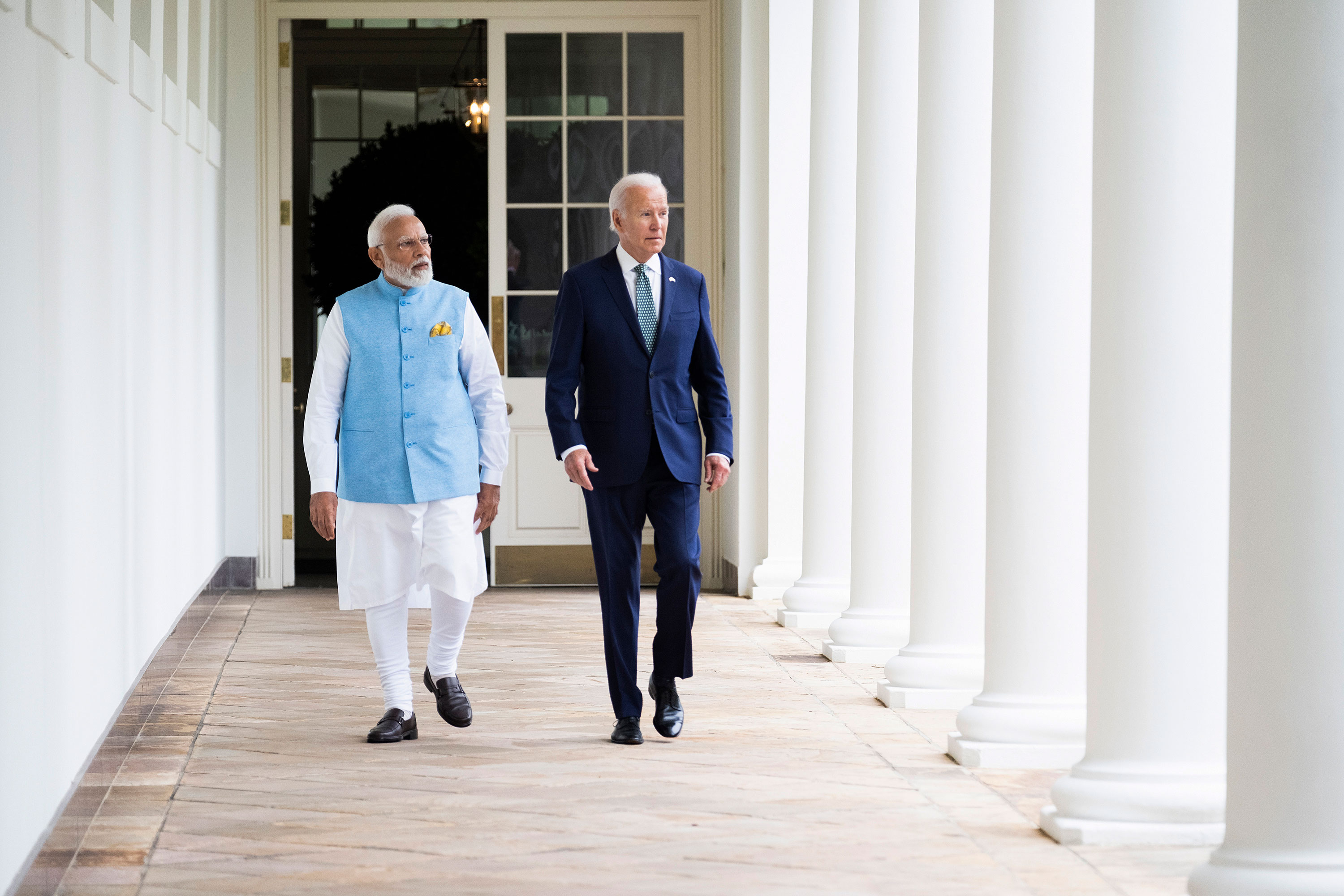
Indian Prime Minister Narendra Modi was once shunned by the United States.
Denied a visa for “severe violations of religious freedom,” he was effectively banned from entering the country for nearly a decade.
But in the years since that ban was lifted, Modi has been progressively embraced by the White House.
While the US has positioned itself as a democratic protector in an increasingly populist and polarized era, it has seemingly turned a blind eye to New Delhi’s alleged human rights abuses at home — where the ruling Bharatiya Janata Party has come under scrutiny from rights groups and opposition lawmakers for its increasingly strident brand of Hindu nationalist politics and an ongoing crackdown on dissent.
Modi and India, the world’s largest democracy, are necessarily a lynchpin in Biden’s strategy in Asia. As the world’s most populous country, no major global challenge, from climate change to advances in technology, can be addressed without India’s buy-in, in Biden’s view.
Both New Delhi and Washington are becoming increasingly uneasy about Beijing’s growing military might, aggressive territorial claims on land and at sea, and growing economic influence over its smaller neighbors.
In an era of growing tensions between the US and China, there are few partners that Biden is more eager to cultivate.
What's changed since India's first election?
From Esha Mitra in New Delhi
India’s first general elections began in October 1951, four years after it gained independence from British rule, and soon after it became a republic in 1950.
The election lasted about four months and the Indian National Congress emerged victorious in February 1952.
Population boom: India then had a population of about 361 million people with 173 million registered electors.
Since then, the population has increased nearly four-fold to 1.429 billion , with more than five times the number of eligible voters, according to the Election Commission of India.
From paper to voting machines: In the first elections, Indians used paper ballots to cast their votes.
Electronic voting machines were first used in the state of Kerala in 1982. But because there was no law prescribing their use, the Supreme Court struck down that election. In 1989 laws were amended to allow the use of voting machines after consensus was reached.
In recent years, the validity of voting machines has again been questioned — this time by opposition parties that say they are being misused to favor the ruling Bharatiya Janata Party (BJP) — an allegation the BJP denies.
In an India divided by prosperity and poverty, whose dreams come true?
From CNN's Jessie Yeung, Priti Gupta and Esha Mitra

At 7 a.m., Rupali Rao Kilare starts getting ready for the day in the cramped home she shares with five family members.
Though the sun has long risen, some alleys remain pitch dark as she weaves through the slum where she lives in Mumbai’s Goregaon West neighborhood, its narrow walls wedged between tightly packed buildings that block the light.
Kilare, 22, must hurry to beat the crowds at the slum’s communal toilets, before taking a three-wheeled auto-rickshaw to her boss’ home for her cleaning shift.

Just 3 miles (about 5 kilometers) away in Goregaon East, Shreya Verma, 26, stirs awake in her air-conditioned bedroom, pulls back the curtains and takes in the view of greenery and high-rise buildings.
Throwing on a blazer and heels, she hops in an Uber to her marble-floored office at an international tech firm.

Though the two women are separated by only a few years in age and a 20-minute drive, their starkly different lives illustrate India’s deepening wealth divide – and the inequality that has empowered some to reach new heights alongside the country’s fast-growing economy, while others are left behind.
That inequality has come under particular scrutiny during India's election.
Though Prime Minister Narendra Modi has been credited with advancing India’s $3.7 trillion economy and bringing the country closer to becoming a global superpower, India remains a largely impoverished nation and its wealth gap is more unequal than it was during British rule.
Read the full story.
Please enable JavaScript for a better experience.
We've detected unusual activity from your computer network
To continue, please click the box below to let us know you're not a robot.
Why did this happen?
Please make sure your browser supports JavaScript and cookies and that you are not blocking them from loading. For more information you can review our Terms of Service and Cookie Policy .
For inquiries related to this message please contact our support team and provide the reference ID below.

IMAGES
VIDEO
COMMENTS
Our 2024 Business Plan sets out how we will continue to create a transport network that serves everyone's needs, while tackling pollution, supporting the UK economy and building a safer, greener and fairer city for all. Our Business Plan maps our plans over the period to 2026/27. It focuses on supporting the Mayor's ambitions around the key ...
Since restrictions were lifted on public transport in early 2022, ridership on Tube, bus and rail services has increased and is now at around 80 per cent, across a weekly average, compared to that seen before the pandemic. ... The draft TfL Business Plan will be considered by the TfL Board on 7 December 2022 and can be viewed here: ...
Draft TfL 2023 Business Plan 2022/23 to 2025/26 Board 7 December 2022. TfL RESTRICTED 1 Objectives of this plan Outcome focused and integrated. ... Three engagement sessions were held to seek views on our Business Plan priorities with Healthy Streets Advisory Group, Business Advisory Group and the Inclusive Transport Forum. Attendee organisations:
This Business Plan includes an updated forecast for 2022/23 and a forward . look from 2023/24 to 2025/26. The updated forecast for 2022/23 aligns this . Business Plan with our funding agreement with the Government, and will be used as our reporting baseline for the rest of this financial year.
On 7 December 2022, the TfL Board . approved our four-year 2023 Business . Plan - our first in three years. The 2023 Business Plan shows how we will support London's economic recovery and keep our city moving. This means we can achieve our vision to be the city's strong, green heartbeat and deliver the goals of the Mayor's Transport ...
PN-154 Five-year plan means continued investment to encourage greater use of public transport, walking and cycling and significantly improving the environment and air quality Firm financial management keeps TfL on track to deliver an operating surplus by 2022/23 with net annual cost of operations reduced by more than £1bn since 2015/16 Delay to the opening of the Elizabeth line and a subdued ...
This Business Plan invests in active travel, rail and buses, tackles air pollution, and helps to create a safer, greener, fairer city ... the provision of capital funding for TfL in 2024-25. This plan will invest £11bn in our roads and rail system. TfL is transforming Elephant ... Throughout 2022/23, our investment amounted to an economic
The Mayor, Sadiq Khan, published the Draft Transport for London (TfL) Business Plan on Thursday 8 December. The plan outlines how TfL will deliver Sadiq's vision for transport over the next five years: an affordable and modern transport network that works for all Londoners. It includes: an ambitious programme of modernisation and transformation.
This will be delivered through a focus on improving efficiencies, driving improvements where possible for TfL colleagues, and an approach to continuous savings, including working together with TfL's supply chain to make further efficiencies. The draft TfL Business Plan will be considered by the TfL Board on 7 December 2022.
Transport for London (TfL) will need to find an additional £600m a year in savings by 2025-26, according to its draft Business Plan. It said it was down to inflation and the requirements of the ...
Rachel McLean, TfL's Chief Finance Officer . Introduction. Our 2023 TfL Business Plan set out our strategy for rebuilding our finances, improving efficiency and helping to secure . our future. The 2023/24 Budget built on . this, demonstrating how we will become operationally financially sustainable by March 2024. We have successfully delivered
52 Sustainable development. This Business Plan includes an updated forecast for 2022/23 and a forward look from 2023/24 to 2025/26. The updated forecast for 2022/23 aligns this Business Plan with our funding agreement with the Government, and will be used as our reporting baseline for the rest of this financial year.
Improving air quality, tackling climate change and investing in public transport are on the agenda for Transport for London's (TfL) latest Business Plan as it looks to support London's economic recovery and improve sustainability, both financially and environmentally by 2023/24.. Across the plan, £8.1bn will be invested in London's road and rail network, as well as funding to boroughs ...
Business Plan 2022-2023 Introduction ... • Persuaded TfL to drop their plan to make all stations in London cashless ... And 2022 will be a key year for influencing the shape of the transformation. In the near-term, making sure that timetable changes serve passenger needs is the
Welcome to TfL 11 The TfL Business Plan This describes how we will implement the Mayor's Transport strategy and provide the best value for customers, businesses and London as a whole. This includes a focus on ... 2022 goal. We have a range of initiatives to encourage more active travel, from physically making streets safer and limiting road ...
1.1 This paper considers TfL's 2023 Business Plan, which sets out TfL's plans for the four years from 2022/23 to 2025/26. This is the first detailed medium-term plan we have published since 2019 and underpins TfL's draft Budget submission to the GLA. This plan is built on the funding arrangements in place
As for the Elizabeth line, the network has been a major success for TfL with more than 350million journeys made on its trains since the first service ran on May 24, 2022 - and demand already above ...
The launch of the Elizabeth line in May 2022 transformed TfL's approach to accessibility and TfL is working to make further improvements to its trains and stations in 2023/24, including the completion of step-free schemes at Knightsbridge and the Bakerloo line at Paddington. ... TfL's business plan includes approximately £20m of funding per ...
Transport for London has published its latest Business Plan, which sets out how it aims to support London's economic recovery and "become the green heartbeat of London" whilst achieving operational financial sustainability by 2023/24. It says the plan charts how, across the next three and a half years, TfL will play a key role in improving air quality and tackling the climate emergency ...
The monthly cost of Duo, a plan that lets two people split a premium plan, is rising by $2, to $16.99. The family plan is increasing prices by $3 to $19.99 per month.
Transport for London (TfL) has today published its draft five-year Business Plan covering the period from 2020/21 to 2024/25. Alongside the Mayor's Transport Strategy, the draft plan will be considered by TfL's Finance Committee on 18 December. It sets out how transport will support sustainable growth, making the city a safer, greener and ...
The Organization of the Petroleum Exporting Countries and its allies agreed Sunday to extend a voluntary production cut of 2.2 million barrels of crude oil a day into 2025.
This Budget builds on our 2023 TfL Business Plan, our first business plan since 2019. The Budget updates 2023/24 for the latest information and turns it into a detailed plan, against which we can track progress ... Business Plan. 2022/23 Q1 Forecast (estimate when agreeing funding settlement) Mar23 OBR Latest. 6. 2020 Q2 - 21.0 % 2020 Q3
Figure 1: Current plan for cycling routes - according to the TfL Business Plan Figure 1 represents the current understanding of the 2022 network, according to the latest Business Plan. Taking into account both existing and planned routes, the network will include more than 90km of Cycle Superhighways and 250km of Quietways, as well as
The Indian National Congress is India's main opposition party, and its newly formed INDIA alliance of parties is the only real challenge to the re-election of the ruling Bharatiya Janata Party (BJP).
Mack Real Estate Group has been working since 2022 to prepare 2,300 acres of raw desert land surrounding TSMC for a public auction. The New York firm has placed the winning bid for the land and ...
In 2022/23 TfL invested £6.5bn with 2,072 suppliers. • 93% were based in the UK • Two-thirds were based outside London ... We have maintained this assumption in the 2024 TfL Business Plan. Funding settlements in place for comparable transport authorities in the UK. RIS 2. In July 2023, Government stated it was not possible to provide TfL ...
Elon Musk has agreed to testify in the US Securities and Exchange Commission's probe of his 2022 acquisition of the social-media platform once known as Twitter.. The billionaire will sit for a ...
Transport for London (TfL) brings live poetry readings to Covent Garden station on Monday 3 June, to mark six new poems to be featured on Underground, Overground and Elizabeth line trains this summer. ... 2022. 2021. 2020. 2019. 2018. 2017. 2016. 2015. 2014. 2013. 2012. 2011. 2010. 2009. 2008. 2007. 2006. 2005. 2004. Photos. Contact the Press ...
3.11 Progress updates on the action plan will be provided to future meetings of the Committee as part of the Risk and Assurance quarterly reports. The Anti-fraud and Corruption Policy will be updated to reflect the Counter-fraud and Corruption Plan to 2030. 3.12 Further details of TfL's Counter-fraud and Corruption Plan are set out in the